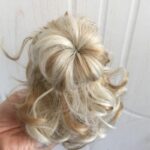笔记: I haven’t owned high-end wigs like CB or SK, and mostly work with affordable ones or modify blank wig bases. I even sewed wefts when I first started the hobby! What I share here is just based on the materials I’ve used myself.
Common Questions
Wig Material Types
High Temperature Fiber
Lightweight, soft, 负担得起. Very shapeable and can generally withstand up to 200°C. Great for beginners.
Heat-Resistant Fiber
Thicker and rougher than high temp fiber. Slightly duller finish. Perfect for wig mods and holds shape well.
Mohair
Made from angora goat hair. Super fine and soft, with an oily texture that’s hard to manage. Loved by some, disliked by others.
Faux Mohair
Synthetic alternative to mohair. Soft but less oily. Easier to handle and great for tight curls and European styles.
Wool Head
Real animal hair. It was trendy but is expensive and tough to style. Mostly faded from popularity.
Protein Fiber
Very natural appearance and shine. Looks like human hair. Can’t be heat styled.
Other Materials (Super Soft, PP, etc.)
Vary by factory. Beyond the common types listed above, always ask the seller if you’re unsure.
Wig Care & Styling
Storing Your Wigs
Stuff the inside to prevent flattening, use a wig net, and keep in a dry, shaded spot. Wigs still get messy over time and will need restyling.
Tools for DIY Styling
- Mini curling iron (children’s version)
- Hair clips
- Scissors
- Steamer (optional)
- Curl rods + hot water method (budget alternative)
Tips for Wig Mods
- Avoid low-quality blanks
- Ask if the wig base supports bangs/cuts
- Use around 120°C heat (start low if unsure)
- Limit heat to 20 seconds max
- Watch video tutorials for visuals and techniques







